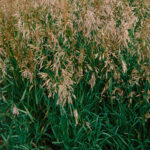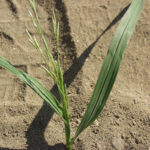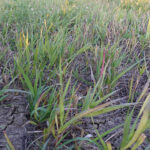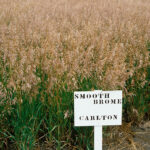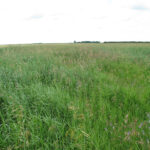Smooth Bromegrass
Bromus inermis
General Description
Smooth bromegrass is a high-yielding, cold hardy, long-lasting, creeping perennial grass. Roots are deep, fibrous, and very fine. Once established it develops creeping rhizomes that can become root bound. Smooth bromegrass is used for forage, roadside site rehabilitation and erosion control.
Stems can reach as high as 1.2 m (48 in) in height. Leaf blades are rolled, hairless, large and wide, up to 1.5 cm (1/2 in). There is often a “W” constriction or “watermark” in the upper leaf. Smooth bromegrass forms long seed heads 20 cm (8 in) long with 7 to 10 spikelets and flowers. It is cross-pollinated and develops seed easily.
Type
Tame grass.
Origin
Europe & northern Asia. Varieties developed in Canada.
Longevity
At least 10 years. Smooth bromegrass is highly naturalized in Canada and found in ditches, field margins, forests, and riparian areas.
Use
Hay, pasture. Smooth bromegrass is also used as stockpiled forage in the Grey and Dark Grey soil zones and Peace River region where higher moisture and cooler temperatures exist. Smooth bromegrass is the most commonly grown as grass for hay. It is used for roadside site rehabilitation and erosion control, and for forage in forest land grazing contexts but increasingly being avoided in many areas because of its invasive nature.
Hay, silage, pasture. Smooth bromegrass may also used as stockpiled forage where higher moisture and cooler temperatures exist. Smooth bromegrass is the most commonly grown as grass for hay. It is used for roadside site rehabilitation and erosion control, and for forage in forest land grazing contexts but increasingly being avoided in many areas because of its invasive nature.
Optimal Time of Use
Variable depending on the soil zone or region. Smooth bromegrass provides good early season grazing. All but the brown soil zone can see good fall use of smooth bromegrass. In the cooler, higher moisture regions (Greys, Peace River) winter use is common. Haying smooth bromegrass between heading and flowering provides good yield and quality. A second cut may be taken or grazed ensuring 15 cm (6 in) of growth at frost.
Variable depending on the soil zone or region. Smooth bromegrass provides good early season grazing. Most regions can see good fall use of smooth bromegrass. In the cooler, higher moisture regions winter use is possible. Haying smooth bromegrass between heading and flowering provides good yield and quality.
Recovery After Use
Recovery of 60-80 days is required in most areas (more in dryer regions, less in cooler, moisture regions). Smooth bromegrass can be continually or rotationally grazed. Regrowth is greater if the first grazing occurs before stem elongation.
Smooth bromegrass can be continually or rotationally grazed. Regrowth is greater if the first grazing occurs before stem elongation. Ensure 15 cm (6 in) of growth at frost.
Palatability/Nutritional Value
Very palatable to livestock when young. Palatability does decline once headed. Hay nutritional values are generally 11 to 14% protein and 64% digestibility.
Annual Precipitation min/max (mm)
1350mm / 1500mm
N/A
Drought Tolerance
Good tolerance. While smooth bromegrass survives drought well in drier soil zones, growth is most often depressed during extreme droughts.
Good tolerance. Droughts in the Black and Grey(s) soil zones are well tolerated. While smooth bromegrass survives drought well in drier soil zones, growth is most often depressed during extreme droughts.
Flooding Tolerance
Withstands 2-5 weeks of spring flooding. Often found invading riparian zones.
Winter Hardiness
Excellent hardiness. Sod allows it to survive nearly any winter situation.
Soil Texture Preference
Smooth bromegrass is adapted for all soils. It yields the highest on fertile loamy soils.
Erosion Control
Excellent for erosion control. Smooth bromegrass forms sod.
Salinity Tolerance
Moderate tolerance. When seeded in saline areas, smooth bromegrass will grow on patches and margins with lower salt levels. As its growth helps lower the salinity levels, it then can spread and fill in gaps.
Acidity Tolerance
Moderate tolerance. Smooth bromegrass tolerates pH levels as low as 5.5, but is most productive on soils with pH 6.0 to 7.5.
Alkalinity Tolerance
Moderate tolerance.
Seeds per kg
315,000 seeds/kg (143,000 seeds/lb)
Suggested Mixtures
One of the most widely seeded grasses. Often seeded with alfalfa and timothy (area dependant). Stand is best managed to maintain a desired percentage of alfalfa in the stand. If seeded with other grasses smooth bromegrass will tend to outcompete the other grass in a short period. Is now being replaced with meadow or hybrid bromegrass due to their palatability and less competitive nature.
Ease of Establishment
Seed-to-soil contact is important when establishing smooth bromegrass, but it is widely adapted to a broad range of seedbed conditions. Smooth bromegrass seed germinates easily into strong seedlings but stand takes time to establish and thicken in the first year. Seed is ‘fluffy’ in nature.
Competitiveness
High competitiveness and invasiveness.
Smooth bromegrass is included on the E-Flora BC 2011 Invasive, Noxious and Problem Plants of British Columbia. It can become invasive on upland range and wetland areas.
Management Considerations
Smooth bromegrass stands respond well to fertilization and need to be fertilized to favour and maintain legumes in mixed stands. Consider seeding a higher percentage of a legume initially as smooth bromegrass will spread and increase in the stand over time. It is not a good candidate for stockpiling for use in early spring as it does not maintain its feed quality over the winter.
British Columbia Rangeland Seeding Manual, Saskatchewan Dryland Forage Species Adaptation Tool, USDA Plants Database, Alberta Forage Manual, Manitoba Forage Adaptation and Comparison Guide, OMFRA Publication 30
Smooth bromegrass is adapted to the Sub-Boreal Spruce, Interior Cedar-Hemlock and Sub-Boreal Pine-Spruce zones. In the southern part of the region, it is adapted to the Interior Douglas-fir zone and to irrigated and subirrigated areas in the Bunchgrass zone. It is very persistent where it is adapted and may invade native plant communities in these areas.
Smooth bromegrass is adapted to dryland applications in the Interior Douglas-fir zone, the Interior Cedar-Hemlock zone, and to irrigated and subirrigated areas in the Bunchgrass and Ponderosa Pine zones. It is very persistent where it is adapted and may invade native plant communities in these areas.
